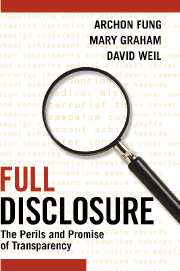Book contents
- Frontmatter
- Dediaction
- Contents
- List of Figures and Tables
- Preface
- 1 Governance by Transparency
- 2 An Unlikely Policy Innovation
- 3 Designing Transparency Policies
- 4 What Makes Transparency Work?
- 5 What Makes Transparency Sustainable?
- 6 International Transparency
- 7 Toward Collaborative Transparency
- 8 Targeted Transparency in the Information Age
- Appendix: EighteenMajor Cases
- Notes
- Bibliography
- Index
4 - What Makes Transparency Work?
Published online by Cambridge University Press: 27 July 2009
- Frontmatter
- Dediaction
- Contents
- List of Figures and Tables
- Preface
- 1 Governance by Transparency
- 2 An Unlikely Policy Innovation
- 3 Designing Transparency Policies
- 4 What Makes Transparency Work?
- 5 What Makes Transparency Sustainable?
- 6 International Transparency
- 7 Toward Collaborative Transparency
- 8 Targeted Transparency in the Information Age
- Appendix: EighteenMajor Cases
- Notes
- Bibliography
- Index
Summary
In Los Angeles County, as in other localities, public health inspectors visit restaurants to make sure they comply with local hygiene codes. In most communities, however, the information they collect is locked away in government files. In a few, inspection results are posted in searchable electronic databases that foresighted and tech-savvy restaurant-goers may learn to access. But Los Angeles County goes much further. Since 1998, restaurant managers there have been required to post in their windows a letter grade ranging from A to C that reflects the results of their most recent hygiene inspection. Would-be patrons needn't call the public health office or visit a Web site. A glance at the restaurant's storefront tells them how clean it is and lets them incorporate that information into one of the most common of daily decisions – figuring out where to eat.
These restaurant hygiene reports have created powerful incentives for restaurateurs to clean up their premises. Early research has found significant revenue increases for restaurantswith high grades and revenue decreases for C-graded restaurants (a powerful effect). More important, research results suggest that the policy has caused ameasurable increase in restauranthygiene and a significant drop in hospitalizations from food-related illnesses (a clear sign of effectiveness). Thus, more-informed choices by consumers appear to be improving restaurant cleanliness, rewarding restaurateurs who practice good hygiene, and stimulating a new dimension of beneficial competition among restaurants.
This restaurant grading system illustrates how a thoughtful public policy can generate information that is genuinely helpful to people in their everyday decisions. What makes the Los Angeles County system so successful? More generally, what separates the transparency policies that succeed from those that fail? In this chapter,we try to answer these questions by examining eight major U.S. targeted transparency policies: corporate financial reporting, restaurant hygiene disclosure, mortgage lending disclosure, nutritional labeling, toxic pollution reporting, workplace hazardous chemicals disclosure, patient safety reporting,andplant closing reporting (showninTable 4.1 and explored in subsequent tables).
We focus on this subset of the full database of policies because we can take advantage of a significant body of quantitative policy evaluations and other literature that has developed in recent years. Although these evaluations examine specific policies, they provide us with a means to look deeply at the crosscutting drivers of success. Thus the eight policies provide a particularly sharp means of evaluating the effectiveness of targeted transparency.
- Type
- Chapter
- Information
- Full DisclosureThe Perils and Promise of Transparency, pp. 36 - 105Publisher: Cambridge University PressPrint publication year: 2007
- Creative Commons
- This content is Open Access and distributed under the terms of the Creative Commons Attribution licence CC-BY-NC 4.0 https://creativecommons.org/cclicenses/



